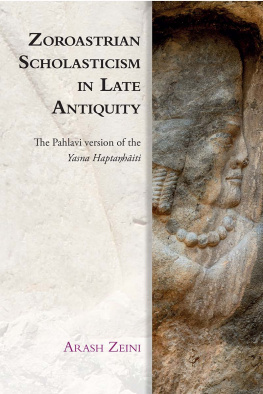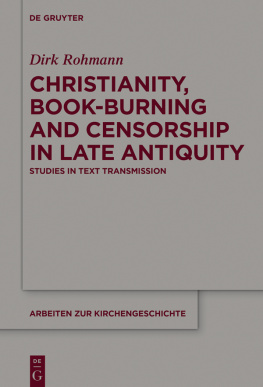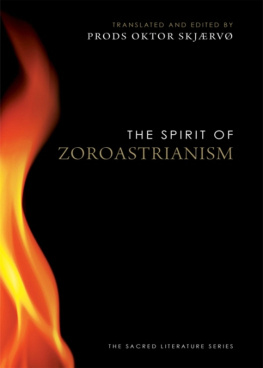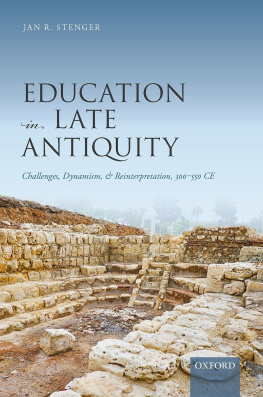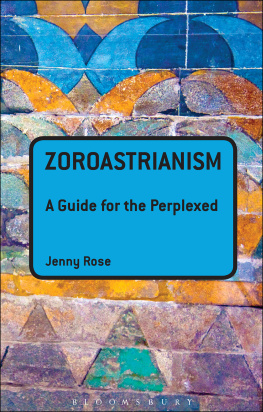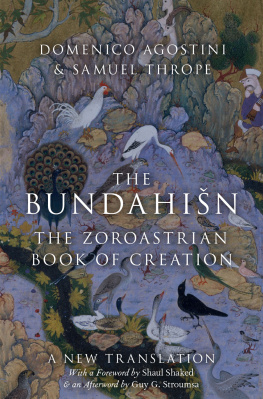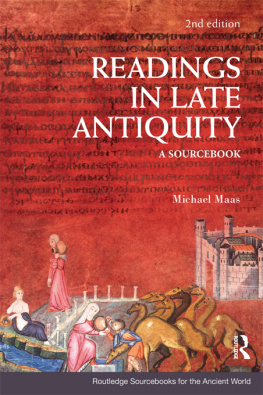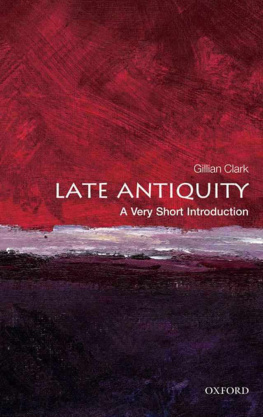
Zoroastrian Scholasticism in Late Antiquity
EDINBURGH STUDIES IN ANCIENT PERSIA
SERIES EDITOR
Lloyd Llewellyn-Jones, Cardiff University
EDITORIAL ADVISORY BOARD
Touraj Daryaee, Andrew Erskine, Thomas Harrison, Irene Madreiter,
Keith Rutter, Jan Stronk
TITLES AVAILABLE IN THE SERIES
Courts and Elites in the Hellenistic Empires: The Near East After the
Achaemenids, c. 330 to 30 BCE
Rolf Strootman
Greek Perspectives on the Achaemenid Empire: Persia through the
Looking Glass
Janett Morgan
Semiramis Legacy: The History of Persia According to Diodorus of Sicily
Jan P. Stronk
ReOrienting the Sasanians: East Iran in Late Antiquity
Khodadad Rezakhani
Sasanian Persia: Between Rome and the Steppes of Eurasia
Edited by Eberhard W. Sauer
Plutarch and the Persica
Eran Almagor
Archaeology of Empire in Achaemenid Egypt
Henry P. Colburn
Zoroastrian Scholasticism in Late Antiquity: The Pahlavi Version of the Yasna Haptahiti
Arash Zeini
FORTHCOMING TITLES
Achaemenid Kingship, Alexander the Great and the Early Seleucids: Ideologies of Empire
Stephen Harrison
Socioeconomic Transformation in the Sasanian Empire: Late Antique Central Zagros
Hossein Habibi
The Bactrian Mirage: Iranian and Greek Interaction in Western Central Asia
Michael Iliakis
Visit the Edinburgh Studies in Ancient Persia website at
edinburghuniversitypress.com/series/esap
Zoroastrian Scholasticism in Late Antiquity
The Pahlavi version of the Yasna Haptahiti
Arash Zeini

Edinburgh University Press is one of the leading university presses in the UK. We publish academic books and journals in our selected subject areas across the humanities and social sciences, combining cutting-edge scholarship with high editorial and production values to produce academic works of lasting importance. For more information visit our website: edinburghuniversitypress.com
Arash Zeini, 2020
Edinburgh University Press Ltd
The Tun Holyrood Road,
12(2f) Jacksons Entry,
Edinburgh EH8 8PJ
A CIP record for this book is available from the British Library
ISBN 978 1 4744 4291 6
The right of Arash Zeini to be identified as the author
of this work has been asserted in accordance with the Copyright,
Designs and Patents Act 1988, and the
Copyright and Related Rights Regulations 2003
(SI No. 2498).
Contents
List of Figures
List of Tables
Acknowledgements
I am delighted to express my gratitude to a number of individuals whose support has been crucial to the realisation of this project, which goes back to my doctoral research at the School of Oriental and African Studies, University of London. First and foremost, I must thank Almut Hintze, at whose suggestion I began working on the Pahlavi version of the Yasna Haptahiti. I am deeply indebted to Nicholas Sims-Williams for his generous counsel. Franois de Blois, the quiet man of Iranian Studies, offered insightful comments on early drafts and played an instrumental role in discovering the joy of academic curiosity. Alan Williams and Judith Josephson contributed much to this work with their constructive feedback and criticism.
I have greatly appreciated many illuminating discussions with Oktor Skjrv. He generously shares with me and the scholarly community a vast array of his unpublished material, which I have used extensively throughout my work. Maria Macuch also trusted me with unpublished material that proved very useful. Dan Sheffield and Yuhan Vevaina deserve special thanks for responding to various calls for help. I owe thanks to Miguel ngel Andrs-Toledo, Adam Benkato, Shervin Farridnejad, Juanjo Ferrer, Gtz Knig, Maria Kritikou, Cline Redard, Kianoosh Rezania, Shai Secunda, Dan Shapira, Ursula Sims-Williams, Samuel Thrope, Mihaela Timu and the late Carsten Bettermann. I am glad Leon Goldman put his fear of technology aside on a daily basis to call me. It is always good to talk. To Alberto Cantera I am grateful for his friendship and the quality of questioning everything. Jan Espelta, an old friend, with whom I first watched Die Reise des Lwen, I owe thanks for good old times. Thank you for introducing me to Howard Anthony Trott, a lovely man and father. I wonder what became of him. I thank Claudius Naumann, from Freie Universitt Berlin, for kindly providing me with his Pahlavi font.
I am grateful to the Arts and Humanities Research Council, the Ouseley Memorial Fund and the Soudavar Foundation, whose funding helped support my research. The images of the manuscripts used in this book are from the Avestan Digital Archive, Freie Universitt Berlin, and published with their permission.
It is my pleasure to express my gratitude towards the amazing staff of the Edinburgh University Press for their relentless assistance throughout the publication process.
I dedicate this book to my sons, Hourmazd and Siavash, my best friends, and a source of constant joy and much trouble too. I owe them more than they can imagine and am certain Robert Walser would have been envious of our walks.
Series Editors Preface
Edinburgh Studies in Ancient Persia focuses on the world of ancient Persia (pre-Islamic Iran) and its reception. Academic interest with and fascination in ancient Persia have burgeoned in recent decades and research on Persian history and culture is now routinely filtered into studies of the Greek and Roman worlds; Biblical scholarship too is now more keenly aware of Persianperiod history than ever before; while, most importantly, the study of the history, cultures, languages and societies of ancient Iran is now a wellestablished discipline in its own right.
Persia was, after all, at the centre of ancient world civilisations. This series explores that centrality throughout several successive Persian empires: the Achaemenid dynasty (founded c. 550 BCE) saw Persia rise to its highest level of political and cultural influence, as the Great Kings of Iran fought for, and maintained, an empire which stretched from India to Libya and from Macedonia to Ethiopia. The art and architecture of the period both reflect the diversity of the empire and proclaim a single centrally constructed theme: a harmonious world-order brought about by a benevolent and beneficent king. Following the conquests of Alexander the Great, the Persian Empire fragmented but maintained some of its infrastructures and ideologies in the new kingdoms established by Alexanders successors, in particular the Seleucid dynasts who occupied the territories of western Iran, Mesopotamia, the Levant and Asia Minor. But even as Greek influence extended into the former territories of the Achaemenid realm, at the heart of Iran a family of nobles, the Parthian dynasty, rose to threaten the growing imperial power of Rome. Finally, the mighty Sasanian dynasty ruled Iran and much of the Middle East from the third century CE onwards, proving to be a powerful foe to Late Imperial Rome and Byzantium. The rise of Islam, a new religion in Arabia, brought a sudden end to the Sasanian dynasty in the mid-600s CE.
These successive Persian dynasties left their record in the historical, linguistic and archaeological materials of the ancient world, and Edinburgh Studies in Ancient Persia has been conceived to give scholars working in these fields the opportunity to publish original research and explore new methodologies in interpreting the antique past of Iran. This series will see scholars working with bona fide Persian and other Near Eastern materials, giving access to Iranian self-perceptions and the internal workings of Persian society, placed alongside scholars assessing the perceptions of the Persianate world from the outside (predominantly through Greek and Roman authors and artefacts). The series will also explore the reception of ancient Persia (in historiography, the arts and politics) in subsequent periods, both within and outwith Iran itself.
Next page
